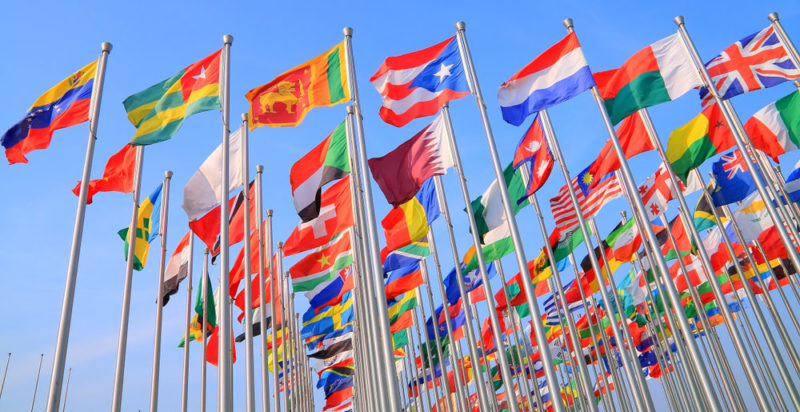We explain what nationalism is and when it emerged. Also, types of nationalism, examples and characteristics.

What is nationalism?
Nationalism is the ideology and political movement that exacerbates the sense of belonging and identity that an individual or group has about their nation While the patriot is one who feels love for his country, the nationalist requires a clear political position, generally associated with a party and tending towards action.
Nationalism defends the union of State and nation (understanding the nation as the basis of the State) and the common traits among the individuals who inhabit it (language, culture, customs, traditions). Furthermore, it postulates the need to govern and inhabit all the territory that is considered the nation's own, this has been cause of long debates and wars between nations
See also: Globalization
When did the concept of nationalism arise?
nationalism It is a product of modernity so talking about him before this period is an anachronism.
Although we can find precedents for what nationalism would be in certain reactions against feudalism by an incipient bourgeoisie, the concept of nationalism is associated with emergence of states as a center of social and political organization.
The rise of nationalism went through different stages, seeing his harshest expression during the 20th century, when ideologies such as Nazism in Germany, Francoism in Spain or fascism in Italy showed how dangerous the exacerbation of nationalisms is.
The most resonant case is that of Germany, Adolf Hitler channeled German discontent and frustration over the defeat of the First World War into an exacerbation of national identity and racism. Nationalist pride became the justification for a despotic regime, which believed that its country was destined to occupy a preferential place with respect to other countries and cultures.
Exacerbated nationalism can lead to acts of xenophobia, discrimination, and violence.
Types of nationalism

- Liberal nationalism. It identifies each nation with the liberal values of equality, tolerance and freedom coupled with active participation of citizens. For liberal nationalism, the emergence of each nation is the product of the will of the citizens that make it up.
- religious nationalism Identify each nation with a religion.
- Romantic nationalism It identifies each nation with an ethnicity and reflects ideas of romanticism, such as the development of a national language, the promotion of local customs and traditions.
- Ethnic nationalism It identifies each nation with an ethnicity in which nationality is transmitted from generation to generation.
- Integrative nationalism It seeks the union of populations with common traits that inhabit and are part of different states.
- Disintegrative nationalism It seeks the separation of a minority from the State of which it is a part because it has traits that differentiate it from the majority.
Characteristics of nationalism
- Use symbols. Flags, anthems, and saints are used by nationalism to exacerbate a national identity and mark differences with respect to other nations.
- It uses common elements Language, historical stories, culture and religion are used by nationalism to generate identity and foster internal unity.
- It is based on the idea of a nation-state. The figure of a nation is used, which is delimited by a territory inhabited by a population that shares characteristics and is administered by political power.
- Fosters a feeling of belonging. National identity is exacerbated to generate ties between citizens.
- Promotes difference between nations. Some external figure is used as an enemy of the nation to justify their nationalist ideas and actions. Excessive pride in belonging to a nation provokes feelings of superiority in individuals with respect to individuals from other nations.
Causes of nationalism
Among the main causes that motivate individuals to adhere to nationalist ideologies or groups are:
- External threat. It occurs when the population of a country feels threatened by another nation and seeks to defend its identity.
- Need to belong. Man is a social and tribal being who seeks to belong to groups and identify with their members. Belonging to a nation grants identity and allows the full development of citizens.
Nationalism and patriotism
The terms nationalism and patriotism are frequently used synonymously, because they both refer to the idea of the nation-state. However, they are very different concepts from each other, it is even said that nationalism is contrary to patriotism.
On the one hand, Patriotism is understood as the feeling of belonging that an individual has towards his or her country of origin. It manifests itself in the social and cultural sphere and leads it to protect and defend national identity.
On the other hand, nationalism uses that national identity to carry out political action or economic that defends the interests of the nation. This ideology manifests ideas of superiority over other nations or cultures, which differentiates it from patriotism, which does not influence the relationship with other nations.
Nationalism and socialism
Nationalism and socialism are ideologies that are connected, since both are based on the fight against an established order.
Both terms are related to the political current called: national socialism. This term refers to an ideology or form of power that combines both currents and maintains that internal social problems and those of the proletariat can only be solved if national problems are solved.
National socialism ensures that nationalism is the tool capable of solving the social question for which socialism fights.
Examples of nationalism
- Italian unification. During the second half of the 19th century, the seven independent states of the Italian peninsula that shared history, religion and traditions united to form the Kingdom of Italy.
- Afrikaner nationalism During the second half of the 19th century, the Afrikaners (an ethnic community of Dutch origin that lived in Africa) sought to impose their ideology and formed the Boer states, independent republics that settled in the current territory of South Africa.
- Basque nationalism From the 19th century until today, part of the Basque people who inhabit the north of Spain and France defend their nationality (language, traditions, cultural identity) and seek independence and consolidation of their own State.
- Irish nationalism. Emerging in the 19th century, it is a political movement that fights to free the Irish people from the domination of England by defending their culture and their Catholic religion.
- Nazism Emerging in the first half of the 20th century, it was a form of extreme nationalism that promoted and defended German culture and identity and sought to recover the territories that had been part of the Holy Roman Empire. It was characterized by venerating the image of a leader and by its racist, anti-Semitic ideas and the use of violence as a way to control the masses.
- Fascism. Emerged in Italy at the beginning of the 20th century under the command of Benito Mussolini, it exalted the values of the homeland, the oppression of minorities, the use of violence and expansionist ideas.
- Serbian nationalism Emerging in the 20th century, it was an ethnic nationalism led by the Serbian people that sought to break away from Yugoslavia and form an autonomous state identified with Serbian culture.
Mexican nationalism
Nationalism in Mexico had different stages starting in the 19th century in which it sought to highlight national identity. On the one hand, It was used by an anti-Spanish current that achieved independence from Spain in September 1821
After independence, nationalist movements They sought the unity of races, culture and language to constitute a nation state and fight against separatist movements. The Virgin of Guadalupe was one of the main signs used in rebellions and revolutions that stood as a symbol of Mexican unity.
The Spanish language, the mestizo culture, the Catholic religion or the vindication of the Aztec culture are used as a flag of the nationalist identity that still prevails in Mexico.
Criticism of nationalism
Nationalist ideology has been the focus of much criticism since its emergence in the 19th century. Among the most notable are:
- Generates divisions between countries and cultures which prevents the development of a globalized, open and pluralistic world society.
- Considers one's own race or culture superior with respect to others, which generates rejection of those who are different and closed societies.
- It was the cause of both World Wars that caused an unprecedented escalation of violence, as each country sought to show its power, stand out and differentiate itself from the others.
- Use violence as a control mechanism and symbol of power.
- Produces serious consequences due to immigration restrictions which generates resentment between people and nations.
- Use the contempt for other nations as a way to consolidate their power and national identity.
- Use cultural and national identity as shield for political and economic decisions.
Continue with: Cultural identity
References
- “Nationalism” in Encyclopedia Britannica.
- “Why nationalism works?” in Foreign Affairs.
- “Nationalism” on Wikipedia.
- “Nationalism and national movements” in Wiley Online Library.
- “German Nazism and Italian fascism, two forms of totalitarianism” in La Vanguardia.





